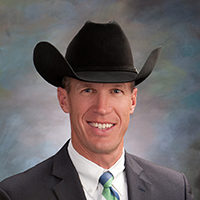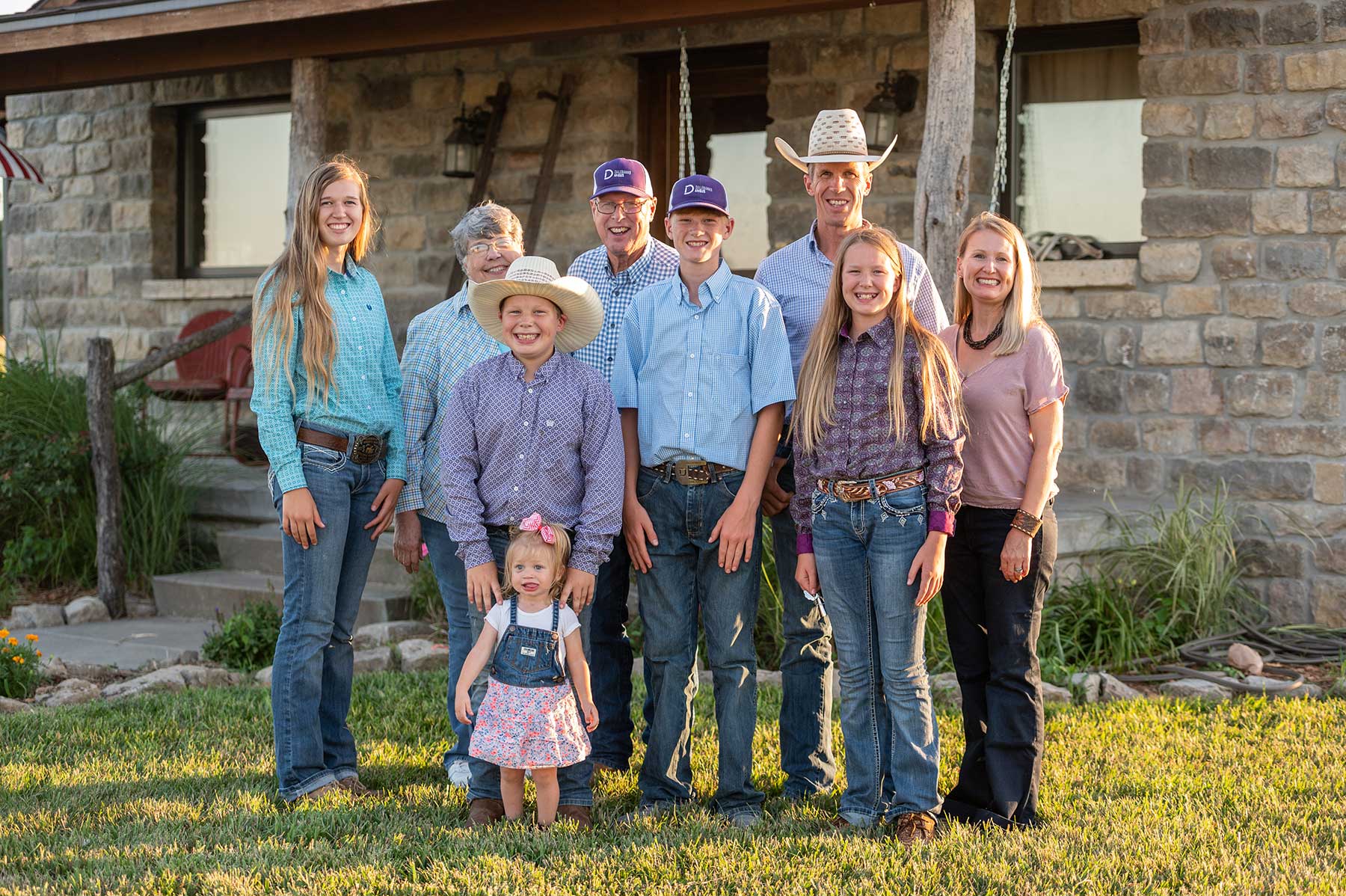BIF President Matt Perrier Leads Both BIF And Dalebanks Angus With Professionalism, Forward Thinking And Perseverance

Fifth generation cattle rancher Matt Perrier grew up in the picturesque Kansas Flint Hills near Eureka. As part owner and manager of Dalebanks Angus he strives to provide genetics to commercial cow-calf and seedstock producers.
“Dad’s ‘office’ was a desk in our family room, and most of my childhood memories were of him on the phone explaining things like adjusted 205-day weights, contemporary groups and eventually expected progeny differences to our bull customers and counterparts in the seedstock business,” Matt recalls. “Some of the biggest advances in technology came when we were able to move from a mass-balance scale to a digital readout in the 1990s. Then came ultrasound, genomics and other technologies. Right or wrong, my ‘ranch lessons’ were often more about proper contemporary groups and ratios than they were about riding and roping.”
Elected to the Beef Improvement Federation (BIF) board of directors in 2016, Matt has served as BIF president for the past year. He will pass the gavel to Vice President Joe Epperly from Albion, Nebraska, during the 2022 BIF Symposium June 3 in Las Cruces, New Mexico.
“To me, BIF is a catalyst for progress in the beef cattle industry,” Matt explains. “That progress isn’t always immediate, polished or perfect, but BIF has a good track record for being the place where industry change is often initiated.”
Matt’s path back to the ranch
Matt earned his bachelor’s degree in Animal Sciences and Industry from Kansas State University. While at K-State he was a member of the meat and livestock judging teams, FarmHouse fraternity and was active in several other campus groups.
After college, he worked for the American Angus Association as a regional manager and later director of commercial and industry relations.
“Working in these roles opened my eyes to the various ways that performance information and genetic predictions are viewed and utilized,” he explains.
Bill Bowman, Method Genetics manager and Matt’s former co-worker at the American Angus Association, says, “Matt was a solution-driven leader with a passion to improve the beef industry. Matt had a thirst to always learn and consider the future of the American Angus Association during his tenure there, and many of the successful programs today were the result of his futuristic thought process. Matt was very service oriented in a member organization, and that characteristic has also served him well in his leadership role at BIF.
“Matt took his experience in all segments of a very diverse beef industry home to Dalebanks Angus, using his knowledge to create practical, profit-oriented genetics, while providing un-matched customer service to their commercial cow-calf clientele.”
Dalebanks Angus was settled by Matt’s ancestors in 1867. The next generation purchased the first registered Angus in 1904, and they have been raising Angus since then.
“We calve about 450 females in separate spring- and fall-calving herds,” Matt explains. “Cows spend all year on grass and are supplemented protein and limited hay in the winter. All breeding-age females are synchronized and artificially inseminated through two heat cycles, then bulls are turned out for 25-45 days.”
Dalebanks markets roughly 200 bulls annually through a fall bull sale and private treaty in the spring. The Perriers have a small farming enterprise of corn, soybeans and wheat that mainly serves to raise feed for the cow herd. “We also grow cover crops on all of our farmed acres, which serves as supplemental forage for pairs during the fall, winter and early spring,” Matt adds.
BIF leadership
“My first contact with BIF was when my parents won the BIF Seedstock Producer Award in 1995. After later attending the Symposia myself in the late 90s and early 2000s as a breed association representative, it’s hard for me to believe that I’m now serving in a leadership role,” Matt explains.
“Some presidents want to ‘leave a legacy’ on the organization that they lead. That hasn’t been my style in past roles, and it certainly wasn’t necessary in this one,” he adds. “Part of BIF’s uniqueness has been its ability to bring hundreds of enormous egos who all believe that their breed, research focus, technology or breeding philosophy are superior; and then put them in a room to listen, share and learn. The ideas that come out of those rooms are often industry-changing and inspiring.
“I consider BIF as a place that brings all segments of beef cattle genetics together to share ideas, debate concepts and methods and then find their own ways to develop and use the information to improve beef production. As president, I didn’t try to improve on that model…I just tried to encourage folks to recognize its unique value and let the model quietly work.”
If you survey BIF Symposium attendees, they’d describe the event as one of the few meetings that draws a balanced representation from the genetic research, teaching, breed association and producer segments of the beef business. For example, a PhD may give a highly technical lecture reviewing research that has been ongoing for years or even decades, one straight-shooting cowboy may then ask a pointed question about said research, and most of the academics and association folks in the room will then spend the rest of the night at the bar debating the viewpoint that the guy with manure on his boots brought to light.
“Most folks in BIF meet each other where we are,” Matt describes. “The scientists simplify their language for me, I (try to) elevate my knowledge closer to their level, and we connect curious minds with a dedication to beef cattle breeding so we can share ideas, challenge each other’s thoughts and hopefully improve our ability to profitably produce genetics that meet the needs of our customers and consumers now and in the future.”
But whether it’s a discussion around the board table or during our annual symposium, most BIF folks look forward to the hard questions that challenge the presenter and help attendees find solutions to the complex challenges in the beef cattle industry. Matt says some of the best Symposia and workshops have been the ones where there was lively debate about an issue or two.
“BIF is one of the few organizations I’ve witnessed that encourages questions and challenging viewpoints,” Matt says. “Whether it’s a political party, cattlemen’s association, social media platform or cable news channel, society today drives folks into rigid segments based upon our viewpoints on a few issues. Once we get into that box, questions or dissenting opinions are often considered wrong, uninformed or even hateful.
“As society narrows its philosophical focus and proprietary nature, I believe that BIF serves as important of a role as ever in the beef industry. Carl Jung said, ‘To ask the right question is already half the solution to the problem,’ and I believe that BIF can continue to help our industry find solutions by encouraging this type of open dialogue.”
Matt was elected to the BIF board during the 2016 Symposium in Manhattan, Kansas. “My tenure on the board would be summarized as one of adaptability,” he says.
Matt says highlights of his tenure have included:
- Thanks to a lot of work by dedicated BIF stakeholders in the academic community, we’ve moved our BIF Guidelines to a Wiki format to better align with today’s technology and needs.
- Due to COVID restrictions, our staff and leadership hosted the first virtual symposium in BIF history in 2020, then used what we learned that year to offer a “hybrid” format (virtual and in-person) Symposium in 2021.
- Last fall, we had a productive strategic planning session with our board and staff members to better position BIF for the next decade of service to the industry. Not only did this help us chart our course, it more importantly gave us the opportunity to look introspectively and determine what our stakeholders truly expect from BIF.
- We vastly increased our communications arm, adding social media platforms, planning a website overhaul, moving the live coverage of our Symposia to our own platforms and distributing countless press releases about award winners, proceedings and other highlights from BIF events throughout the year.
“Matt’s been an exceptional board member,” explains Bob Weaber, BIF executive director. “His experience as both a seedstock breeder and former association staff member provides a unique perspective on the roles and impact of BIF. Matt has been instrumental in the development of the organization’s strategic plan and fulfillment of its mission. Never afraid to ask the hard questions or seek to answer them, Matt’s leadership and passion for our mission has always helped our board and staff stay focused on the opportunities for BIF to positively impact beef cattle genetic improvement.”
Looking forward
“I believe that we are in the midst of a significant transition within the cow-calf segment today,” Matt says. “A variety of factors are driving significant numbers of cows to market, and much of that land is being converted into farm production, residential real estate or yearling grazing acres.
Marketing and political issues are best left out of BIF discussions, but BIF leadership will be faced with a different landscape in terms of average cow herd size, regional distribution and trait emphasis in the coming decade.”
Matt met his wife, Amy, at K-State and the couple has been married for more than 20 years. They have five children — Ava (18), Lyle (16), Hannah (14), Henry (11) and Hope (3). His mom and dad, Carolyn and Tom Perrier, live down the road from them and are still very active in the family business.
“As much as genetic selection and improvement excite me, I’m even more passionate about improving our land management through planted cover crops, managed grazing and improved soil health,” Matt says. “Working with nature to help sustainably raise forages and allowing cattle to be part of this cycle is an area where I believe that we can reduce our expenses and build consumer trust simultaneously, so it can be a win-win.”
Matt believes in service. He is currently vice-chair of the Kansas Health Institute and is a past president of the Kansas Livestock Association and has served on several other local and state volunteer boards.
“Matt Perrier exemplifies a progressive breeder,” summarizes Joe Epperly, 2022 BIF vice president. “He is always looking for the trend and the cutting-edge technology to grow our ability to produce high-quality beef. In his time on the board, he has been a leader that opens the door to ideas. His ability to foster discussion is second to none and that is what BIF is all about. A forum for the best minds to get in a room and discuss any and all ideas that further our mission of beef improvement.”

